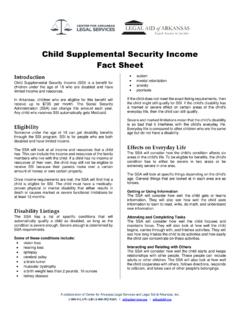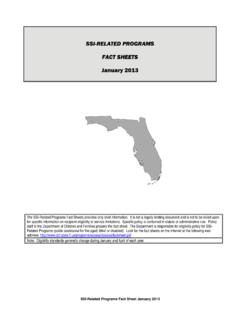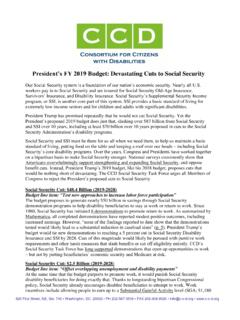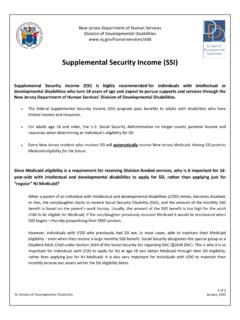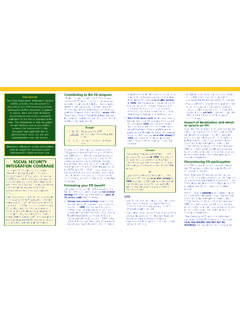Transcription of Social Security Fact Sheet - The Arc
1 SUMMER 20151825 K Street NWSuite 1200 Washington, DC Security insures nearly all Americans and provides benefits to nearly 56 million individuals, including over 12 million people with disabilities, their spouses, and children. Social Security is an interrelated system built up over many decades, so even small changes may affect everyone. Social Security Old Age and Survivors Insurance (OASI) and Disability Insurance (DI) insure workers against poverty in retirement or when disability may limit the ability to work, and provide life insurance for workers survivors.
2 Additionally, spouses and children may receive benefits based on the earnings record of a parent or spouse. People with disabilities and their families access benefits under all parts of the Social Security system, and all parts of the system are important to people with disabilities. Social Security benefits are paid from two Trust Funds (one for OASI and one for DI), which are funded with payroll contributions (FICA taxes) paid by employees and employers. Supplemental Security Income (SSI) is a cash assistance program operated by the Social Security Administration that provides benefits to people who are aged, blind, or have disabilities and have very low income and assets.
3 Over 8 million people receive SSI. Funding for SSI comes from general IssuesPeople with disabilities and their families have an enormous interest in any proposed Social Security or SSI changes. These issues are bipartisan. All policymakers must address the concerns of people with disabilities and their Challenges for the Trust Funds: By law, Social Security s Trust Funds must be able to pay benefits for at least the next 75 years. Social Security is currently running a planned surplus to address the retirement and disability needs of the Social Security fact Sheetbaby boom generation.
4 At the end of 2013 the Trust Funds had reserves of about $ trillion, which are expected to grow to $ trillion by the end of 2020. Social Security s Trustees project that, without any changes, the combined Trust Funds can pay full scheduled benefits until 2033, and would then cover about 77 percent of scheduled benefits. Congressional Action Needed by 2016 to Prevent a 20% Cut in Social Security Disability Insurance (SSDI): On its own, the DI Trust Fund is projected to be able to pay full scheduled benefits through the end of 2016.
5 After 2016, the DI fund s reserves are projected to be depleted, and SSDI would only be able to pay about 80 percent of scheduled benefits, based on money coming into the system. Social Security s actuaries estimate that temporarily raising the share of FICA taxes going to the DI Trust Fund would enable both funds to pay full scheduled benefits through 2033. This process, called reallocation, can only happen if Congress acts. Congress has authorized this kind of shift 11 times in the past, about equally from one Trust Fund to the other, and has always done so in a bipartisan manner.
6 Cuts to Social Security and SSI Would Harm Beneficiaries with Disabilities: Proposals to cut Social Security or SSI benefits could result in significant harm to beneficiaries with disabilities, who often rely on these extremely modest benefits to meet most or all of their daily living expenses. The Arc opposes cuts to eligibility and benefits, including proposals to cut SSDI for people who also receive Unemployment Insurance (UI). Currently, individuals may receive benefits from both UI and SSDI because they receive SSDI, have attempted to work, but lost their job through no fault of their own and as a result also qualify for UI.
7 Proposals to cut these concurrent benefits would single out SSDI beneficiaries and treat them differently Page 1 of 2 Key Message to CongressCongress must preserve Medicaid, Medicare, Social Security , SSI, and other vital programs for people with all other workers under the UI program, create new disincentives to work in the SSDI program, and erode the economic Security of SSDI beneficiaries and their Needed: Many parts of the SSI and Social Security disability systems need to be strengthened to better meet the needs of people with disabilities.
8 These include: increasing the substantial gainful activity (SGA) level for people with disabilities (currently $1,090 per month) to the level for people who are blind (currently $1,820 per month); increasing, and indexing for inflation, the asset limits and income exclusions for SSI; eliminating marriage penalties for people with disabilities; eliminating the two-year waiting period for Medicare; improving work incentives; and addressing policy issues which have a harsh impact on people eligible for Title II benefits as disabled adult Congress should promptly reallocate Social Security pay-roll taxes to prevent a 20 percent across-the-board cut in SSDI benefits at the end of 2016 and to ensure that SSDI can pay full scheduled benefits through 2033.
9 Congress should reject proposals to do a short-term financial patch for the DI Trust Fund, or to include cuts to benefits or eligibility along with reallocation. Congress should consider Social Security and SSI outside of deficit reduction and should reject benefit cuts, in-cluding cuts to concurrent SSDI and UI benefits. Congress should address the many areas in which improvements are needed in the SSI and Social Security disability programs. Congress should request a beneficiary impact state-ment on any proposal to change Social Security , to look beyond budgetary issues to the impact on people s daily 2 of 2 Social Security fact Sheet continuedApril 30, 2015


